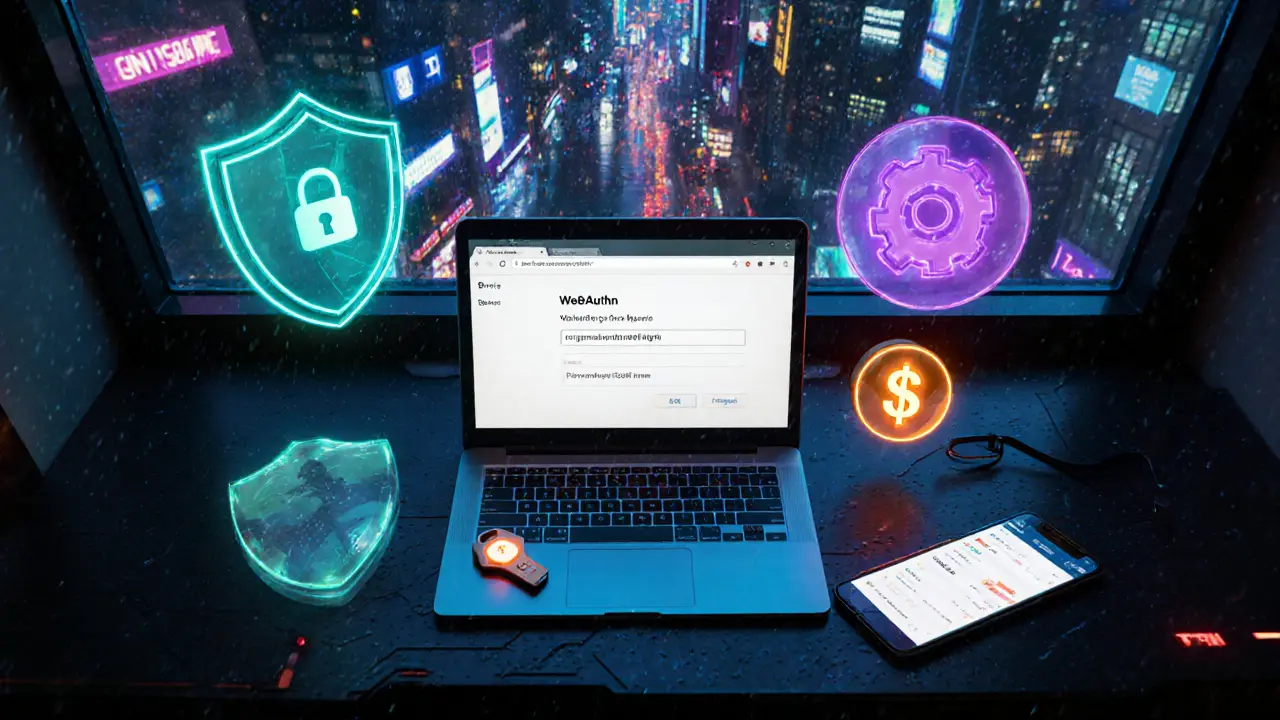MFA Method Selector
This tool helps you choose between hardware 2FA keys and software authenticators based on your priorities. Select your main concern below:
Hardware 2FA Keys
- Strongest phishing resistance
- Private keys stay on device
- Works with passwordless login
- $20-$80 per key
Software Authenticators
- Sync across devices
- Free or low-cost
- Easy setup with QR codes
- Works on any device
Recommended Approach
How to Get Started
For Hardware Keys: Purchase a YubiKey or similar device, enable WebAuthn on supported services, and carry it with you for secure authentication.
For Software Authenticators: Install a free app like Google Authenticator or Microsoft Authenticator, scan QR codes to add accounts, and consider backup options.
When you add a second factor to your login, the choice between a physical key and an app‑generated code can feel like a trade‑off between security and convenience. Hardware 2FA keys are tamper‑resistant devices that store private cryptographic keys and speak the U2F, WebAuthn, or FIDO2 standards sit on one side of the aisle, while software authenticators are mobile or desktop apps that generate Time‑Based One‑Time Passwords (TOTP) using a shared secret occupy the other. This article breaks down the two approaches, shows where each shines, and helps you decide what fits your workflow, budget, and risk profile.
Quick Takeaways
- Hardware keys use public‑key cryptography, keeping private keys locked inside the device.
- Software authenticators rely on symmetric secrets that live on your phone or computer.
- Keys are virtually immune to phishing; apps are vulnerable if the host device is compromised.
- Keys cost $20‑$80 each; most apps are free.
- If you need cross‑device access, an authenticator app wins; if you need the strongest protection, a hardware key wins.
How the Two Technologies Work
Understanding the underlying mechanics makes the pros and cons click into place.
Hardware 2FA keys generate a unique public‑key pair for every service you register. The private key never leaves the chip, which is built to resist tampering and side‑channel attacks. When you log in, the service sends a cryptographic challenge that includes its domain name. The key signs the challenge with the private key, and the service verifies the signature using the stored public key. Because the signature is bound to the exact domain, a phishing site can’t replay the response - a core feature of the U2F Universal 2nd Factor standard and its successor WebAuthn Web Authentication API that extends U2F with richer credential management.
Software authenticators follow the TOTP algorithm defined in RFC6238. During setup, the service shares a secret (usually a 160‑bit base‑32 string) with the app. Both the server and the app use the secret and the current Unix timestamp, divided into 30‑second intervals, to compute a 6‑digit code. The server accepts any code that matches the expected value for the current or adjacent interval. This approach is simple, works everywhere, and requires only a QR‑code scan to provision a new account.
Security Deep Dive
From a threat‑model perspective, the main differences are where the secret lives and how attackers can reach it.
- Private‑key isolation: With a hardware key, the private key is sealed inside a secure element. Even if malware runs on your laptop, it can’t extract the key because the signing operation happens inside the device.
- Phishing resistance: The domain‑binding in U2F/WebAuthn means a fake login page can’t trick the key into signing for the wrong site. TOTP apps have no such binding; a phishing site can simply ask you for the current code and the victim will type it in.
- Device compromise: If your phone is rooted, a malicious app could read the TOTP secret from memory or from an insecure backup. Hardware keys are indifferent to the host OS; the only way to misuse them is to possess the physical device.
- Loss and backup: Losing a hardware key without a backup disables access to every account that only trusts that key. Most vendors recommend a second key or backup codes. Software apps can sync across devices (Authy, Microsoft Authenticator) or export the secret, making recovery easier but also expanding the attack surface.
Security researchers consistently rank hardware keys at the top of the MFA hierarchy, followed by push‑based or biometrics, then TOTP apps, and finally SMS or email codes.
Cost and Convenience
Budget and workflow shape adoption as much as pure security.
- Price tag: A basic YubiKey USB‑A/NFC security key from Yubico, priced around $45 or a Feitian ePass FIDO budget-friendly key at $25 is a one‑time expense per device. Authenticator apps like Google Authenticator free TOTP generator for Android and iOS or Authy offers cloud backup and multi‑device sync at no cost are free.
- Setup time: Adding a new TOTP account takes 30‑60 seconds - scan a QR code, name the entry, you’re done. Registering a hardware key involves checking that the service supports U2F/WebAuthn, inserting the key, touching it, and possibly naming the credential. The extra steps matter when you’re onboarding dozens of users.
- Device compatibility: USB‑A, USB‑C, NFC, and Bluetooth variants exist, but not every laptop or phone supports all of them. Software apps run on any smartphone or computer with a camera to read QR codes.
- Daily workflow: A hardware key is a tap‑or‑press away - ideal for password‑less logins on workstations. A TOTP app means pulling your phone, reading a 6‑digit code, and typing it in - a small friction that many users accept for convenience.
When to Choose a Hardware Key
If you manage sensitive data, compliance requirements, or high‑value accounts, the extra cost and added steps pay off.
- Enterprise IT departments looking to meet NIST800‑63B Level3 assurance.
- Financial services handling banking credentials, where phishing is a top threat.
- Developers and DevOps engineers protecting cloud‑infrastructure keys.
- Security‑conscious individuals who already use passkeys (AppleFaceID, WindowsHello) and want a universal fallback.
In these scenarios, a hardware key’s immunity to remote extraction and domain‑specific signing outweighs the inconvenience of carrying a small token.

When a Software Authenticator Makes Sense
For most consumer accounts and small teams, the free, cross‑platform nature of an app is hard to beat.
- Personal email, social media, and cloud storage where the risk is lower than the cost of a lost key.
- Remote workers who switch laptops daily and need a quick way to copy codes across devices.
- Organizations that already use services without U2F support (legacy VPNs, older SaaS platforms).
- Anyone who needs backup syncing - Authy’s multi‑device feature lets you recover codes even if your phone dies.
Side‑by‑Side Comparison
| Attribute | Hardware 2FA Keys | Software Authenticators |
|---|---|---|
| Security model | Public‑key crypto, private key never leaves device | Symmetric secret stored on device |
| Phishing resistance | Domain‑bound signatures (U2F/WebAuthn) | Code can be entered on phishing site |
| Cost per user | $20‑$80 (one‑time) | Free (apps) or minimal sync fee |
| Setup complexity | Check service support, insert key, touch it | Scan QR code, name entry |
| Device support | USB‑A/C, NFC, Bluetooth variants; limited on some phones | iOS, Android, Windows, macOS, Linux |
| Recovery options | Backup key or printed codes | Cloud sync, backup codes, export |
| Usability | Tap/press - no typing | Read 6‑digit code, type it in |
Hybrid Solutions and the Future
Vendors are blurring the line. Modern YubiKeys can generate TOTP codes in addition to U2F/WebAuthn, giving you a single device for both worlds. Passkey technology (AppleFaceID, AndroidBiometrics, WindowsHello) embeds hardware‑backed keys directly in the platform, removing the need for a separate token while keeping the cryptographic strength.
These hybrid approaches let security‑focused teams roll out a “one key to rule them all” strategy: use the hardware‑backed WebAuthn flow where supported, fall back to TOTP on legacy services, and rely on platform passkeys for everyday logins.
Implementation Checklist
- Audit which of your services support U2F/WebAuthn. Make a list of those that only accept TOTP.
- Select a hardware key model that matches your device mix (USB‑C for laptops, NFC for phones).
- Purchase a primary key and a backup key for each user.
- Enroll keys in each supported service: follow the service’s MFA setup wizard, insert the key, and touch it when prompted.
- Enable a software authenticator for services lacking hardware support. Choose an app with secure backup (Authy, Microsoft Authenticator).
- Document recovery procedures: backup codes, secure storage of spare keys, and contact information for support.
- Train users - demonstrate a physical tap, show how to retrieve a TOTP code, and explain what to do if a key is lost.
Common Pitfalls and How to Avoid Them
- No backup key: If the sole hardware token is misplaced, you’re locked out. Always provision at least one spare.
- Unsupported browsers: Some older browsers don’t speak WebAuthn. Keep a fallback TOTP method for those cases.
- Phone infection: Malware can read TOTP secrets. Use a reputable authenticator app and keep the OS patched.
- Over‑reliance on one factor: Pair a hardware key with a strong password or passphrase. MFA is an additional layer, not a replacement for good password hygiene.
Bottom Line
There’s no one‑size‑fits‑all answer. Hardware 2FA keys deliver the highest protection against phishing and remote credential theft, making them ideal for high‑risk accounts, enterprises, and security‑focused users. Software authenticators win on cost, ease of use, and multi‑device availability, fitting the majority of consumer and small‑team scenarios. A pragmatic strategy blends both: deploy hardware keys where the data is critical, and keep a reliable TOTP app for everything else.

Frequently Asked Questions
Can I use a hardware key on my smartphone?
Yes, if the phone supports NFC (most Android devices) or Bluetooth. YubiKey 5Ci, for example, plugs into Lightning on iOS and USB‑C on Android, letting you tap the key during the login flow.
What happens if I lose my hardware key?
You’ll need a backup key or recovery codes for each account. Most services let you generate printable backup codes when you first enroll the key. Keep those codes in a secure place, like an encrypted password manager.
Are TOTP apps vulnerable to phishing?
Yes. A phishing site can ask you for the current 6‑digit code, and because the code is valid for 30 seconds, the attacker can reuse it instantly.
Do hardware keys work with password‑less login?
Absolutely. Services that support WebAuthn allow you to register a key as the sole credential, eliminating the password entirely. Apple’s “Sign in with Apple” and Google’s “Password‑less” options are examples.
Can I use the same hardware key for multiple accounts?
Yes. Modern keys generate a unique key pair for each service, so the same physical token can protect dozens of accounts without linking them together.


Jacob Anderson
July 8, 2025 AT 03:12Oh great, another $70 USB stick you have to carry-because phishing is sooo hard.
VICKIE MALBRUE
July 11, 2025 AT 22:09You can pick what feels right for you keep it simple and enjoy the extra security it brings
Carl Robertson
July 15, 2025 AT 17:06Every tech decision feels like a battlefield when you stare at those shiny YubiKeys. The hype trains itself into a cult of “only the elite get to be safe.” Meanwhile, your average user just wants to log in without a ceremony. Yet the articles keep painting hardware as the holy grail while ignoring the daily friction. It’s a melodramatic saga of cost versus convenience.
Oreoluwa Towoju
July 19, 2025 AT 12:03Both methods have merit; consider the data you protect and choose the tool that fits your workflow.
Katrinka Scribner
July 23, 2025 AT 07:00Hey guys 😃 I love both! Hardware keys feel like a tiny superhero 🦸♀️ but the apps are super handy when you’re on the go 😂 just remember to backup!
Jason Brittin
July 27, 2025 AT 01:57Sure, spend $50 on a key and feel like a secret agent 😏 or just use the free app and keep your wallet happy 😊
Amie Wilensky
July 30, 2025 AT 20:54In the grand scheme of authentication, one must consider, not only the raw security metrics, but also the user experience, the cost implications, and the administrative overhead; each factor intertwines, creating a complex tapestry that defies simple categorization.
MD Razu
August 3, 2025 AT 15:51When evaluating multi‑factor authentication, it is essential to adopt a holistic perspective that transcends superficial cost comparisons. The hardware token, exemplified by devices such as YubiKey, offers cryptographic isolation that mitigates the risk of credential leakage, a point that cannot be overstated. Yet, this advantage comes at the expense of physical dependency; loss or damage to the token can render access impossible without a pre‑arranged recovery plan. Conversely, software authenticators operate on the principle of shared secrets, which, while convenient, are susceptible to malware that can exfiltrate the seed from a compromised device. Moreover, the user experience differs dramatically: a hardware token requires a tactile interaction, often a single tap, whereas a TOTP app demands the manual entry of a six‑digit code, introducing friction. From an organizational standpoint, deploying hardware tokens incurs upfront procurement costs, licensing for management tools, and ongoing logistics for distribution and replacement. Software solutions, in contrast, are typically free, but may necessitate policies for backup and synchronization across devices. Security teams must weigh these operational considerations against the threat model; for high‑value accounts, the marginal cost of a hardware token may be justified by the reduction in phishing susceptibility. On the other hand, for low‑risk services, the convenience of an app may outweigh the incremental security benefit. Additionally, regulatory frameworks such as NIST 800‑63B explicitly reference hardware‑based authenticators for higher assurance levels, reinforcing their suitability for compliance‑driven environments. Users should also be educated on the importance of safeguarding their second factor, regardless of its form, to prevent social engineering attacks. In practice, many organizations adopt a hybrid approach: hardware keys for privileged access, software authenticators for everyday accounts. This layered strategy leverages the strengths of each method while mitigating their respective weaknesses. Finally, emerging standards like Passkeys aim to blend the security of hardware with the ubiquity of software, suggesting that the dichotomy may soon evolve. Therefore, the decision is less about declaring a winner and more about aligning the authentication method with the specific risk profile, budget constraints, and user workflow.
Charles Banks Jr.
August 7, 2025 AT 10:48Hardware keys? Sure, if you enjoy juggling tiny gadgets. Apps? Just scan and go.
Naomi Snelling
August 11, 2025 AT 05:45What they don’t tell you is that those “secure” USB sticks are probably engineered to feed data back to a hidden agency, turning every login into a silent surveillance operation.
Kate Roberge
August 15, 2025 AT 00:42Everyone praises the hardware keys like they’re the ultimate shield, but for most folks the extra hassle outweighs the marginal security gain.
Ben Dwyer
August 18, 2025 AT 19:38Keep experimenting, you’ll find the right balance that works for your daily routine.
Lindsay Miller
August 22, 2025 AT 14:35It can feel overwhelming, but remember that any extra step you add makes it harder for a bad actor to get in.
Billy Krzemien
August 26, 2025 AT 09:32Think of it as adding another lock on your door; whether it’s a physical key or a digital code, the goal is the same – to keep your valuables safe.
april harper
August 30, 2025 AT 04:29In the theater of cyber‑war, the hardware token stands as the solitary knight, while the software app is the ever‑ready squire, both yearning for the glory of thwarting unseen foes.
Kate Nicholls
September 2, 2025 AT 23:26Both approaches have clear pros and cons; hardware excels in phishing resistance, while software shines in accessibility and cost.
Rajini N
September 6, 2025 AT 18:23For teams, start by cataloguing which services support WebAuthn; deploy hardware keys for those high‑risk platforms and complement them with a reliable TOTP app for the rest.
Waynne Kilian
September 10, 2025 AT 13:20Let’s not pit them against each other – using both can give you the best of security and convenience, fostering a more resilient digital life.
Michael Wilkinson
September 14, 2025 AT 08:17Don’t dismiss hardware keys as gimmicks; they’re a proven defense that you’d be foolish to ignore.